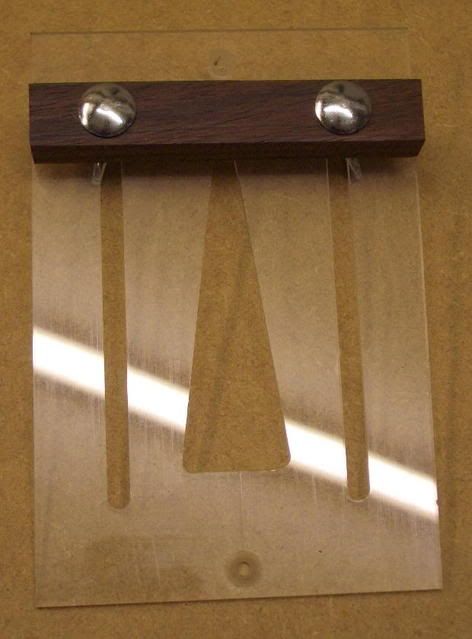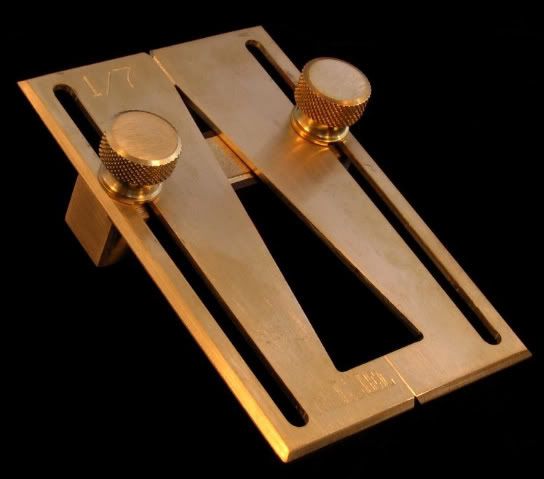|
|
Post by paulchapman on May 28, 2008 20:41:50 GMT
I needed to make a dovetail marking gauge, so I pinched a design from Rob Stoakley (from whom I also pinched the piece of perspex and the piece of Rosewood ;D). Planed one edge of the perspex dead straight, then marked a centre line using a marking gauge. Drilled and countersunk two holes and screwed the perspex to a large-ish piece of MDF. Did all the marking out on the MDF then routed the perspex using a 6mm bit and a slow speed. I've used a slope of 1 in 7. The Rosewood fence is fitted with a couple of M6 coach bolts and wing nuts  I'm quite pleased with how it's turned out. Cheers  Paul |
|
|
|
Post by engineerone on May 28, 2008 21:07:24 GMT
crikey paul that's pretty,  you are surely not going to spoil it and actually use it to mark out dovetails are you ;D ;D paul  |
|
|
|
Post by paulchapman on May 28, 2008 21:16:39 GMT
you are surely not going to spoil it and actually use it to mark out dovetails are you ;D ;D No, I'm only bluffing ;D |
|
|
|
Post by mrgrimsdale on May 28, 2008 21:48:19 GMT
Er, nicely made, but what's wrong with a sliding bevel? Easier to use and you aren't stuck with one arbitrary angle, and its got other uses.
cheers
Jacob
|
|
dunbarhamlin
Full Member
   Lutherie with Luddite Tendancies
Lutherie with Luddite Tendancies
Posts: 244
|
Post by dunbarhamlin on May 28, 2008 22:32:26 GMT
Good stuff. (Rosewood too  ) I use saddles now (sorry Jacob - almost as 'bad' - brass) but used to use a Lufkin which was the same idea (but solid where the holes are, and holes where the solid is) and worked well. Each approach has its pros and cons: this (along with a saddle or DT square) needs no setup and ensures consistency; this (along with a bevel or DT square) gives better stability at the ends; a saddle squares over the end at the same time; a bevel is super flexible. |
|
|
|
Post by paulchapman on May 29, 2008 0:28:28 GMT
but what's wrong with a sliding bevel? I do use a sliding bevel quite frequently but find that when putting it down and picking it up it is very easy to knock the blade out of alignment. For dovetails I think a fixed gauge that will give consistent results is preferable. Cheers  Paul |
|
|
|
Post by paulchapman on May 29, 2008 10:42:17 GMT
Over on the 'other side' BugBear posted a picture of this dovetail marking gauge, which is the same sort of design that I used, which was beautifully made by Ian Dalziel  I thought that Jacob might appreciate the brass knobs ;D Cheers  Paul |
|
|
|
Post by Alf on May 29, 2008 18:23:45 GMT
Very spiffy, Paul. The lovely modern invention of perspex/acrylic really is a bonus - no more faffing around wondering where the marks are underneath, although Ian's brass one does look the part. Is it the Bob Wearing design? Dunno; I went with a Rob Cosman-esque type 'cos I like that I can mark the end grain at the same time. Amazing really, how many different ways there are of skinning the dovetail marking cat - and then there are those who say just cut the darn things by eye. ;D
Cheers, Alf
|
|
|
|
Post by mrgrimsdale on May 29, 2008 19:00:49 GMT
Luvverly knobs! But why only two? There's room for more IMHO.
Thing is though - they look so fiddly to use (the gauge not the knobs) compared to sliding bevel.
NB "the bevel losing its angle by being dropped problem": a. don't drop it, or b. tighten it up a bit more if you really feel that you can't resist the temptation to drop it.
I keep looking at dove tails in old furniture and I have to say that they nearly all seem to be done by eye - the single saw kerf sized ones on drawer sides that is. Its obviously really easy - you mark up the centre line (measured or guessed) for each dovetail on your stack of drawer sides clamped together in a vice, and just saw away at a reasonable gradient - less than say 1/4, more than 1/8 - starting the second cut in the kerf of the first one. I have one set of drawers with 1/3 gradient, which doesn't seem to be a problem.
cheers
Jacob
|
|
|
|
Post by modernist on May 29, 2008 19:51:50 GMT
Is it the Bob Wearing design? . ;D Cheers, Alf Those who know and value his contribution over the years will be sorry to learn that Bob is seriously ill in hospital and his family have had to sell up including his furniture and workshop. If your ever stuck for a design for a bench hook to suit a one armed, left handed woodworker then "Aids and Devices" was the place to look - along with some really useful ideas. Brian |
|
|
|
Post by paulchapman on May 29, 2008 21:15:38 GMT
Those who know and value his contribution over the years will be sorry to learn that Bob is seriously ill in hospital and his family have had to sell up including his furniture and workshop. That's very sad news, Brian. I met Bob at a woodworking show many years ago, where he had several of his excellent workshop devices on show. A really lovely man who was always eager to share his vast knowledge with others. Cheers  Paul |
|
|
|
Post by Alf on May 30, 2008 8:45:50 GMT
Brian, that's sad to hear.  I reckon he must have single-handedly been responsible for more jigs and such than everyone else put together. Cheers, Alf |
|
|
|
Post by engineerone on Jun 2, 2008 21:27:58 GMT
i do not understand the idea that anyone using a jig or a guide is a wooze  having trained as an engineer, i was taught that it is better to rely on jigs for reproducing the same item regularly. so i think that paul is right in using one. cannot see how a bevel is going to allow for repeatability since i certainly can't ensure i keep the screw tight, and as with most carpenter's squares which are notorious for not staying square, it seems to me more sensible to use a jig which cannot be knocked out of shape. i use a number of the veritas jigs, including the saddle square, cause it is properly machined to ensure that it stays square. in addition i have happily this weekend used their dovetail jigs for marking out the leg items on my next table. and why not, it is accurate and does not move. which is surely the important thing for ensuring that things are accurate and repeatable. paul  |
|
|
|
Post by craigmarshall on Jun 2, 2008 21:42:36 GMT
I used a piece of aluminium angle that I found in a bin or something, just cut it to 7 degrees one way then the other on the chop saw and it works beautifully. I also made a 90 degree saddle-square, I thought they would wear out after a bit of use with a marking knife (also home made from a handled and reground jigsaw blade), but they're fine. Not as if it is difficult (1 min) to make another if you need it.
Cheers,
Craig
|
|
|
|
Post by mrgrimsdale on Jun 3, 2008 9:13:25 GMT
What if you drop it? Are they somehow drop resistant as compared to a sliding bevel? And the brass knobs - how come you have enough strength to tighten them, but can't manage the same on a sliding bevel? Good ones have a lever so can be even tighter than a brass knob  if you can imagine such a thing, improbable as it sounds ;D And what if you fancy a different angle just for a change. 10deg? Why not? cheers Jacob |
|